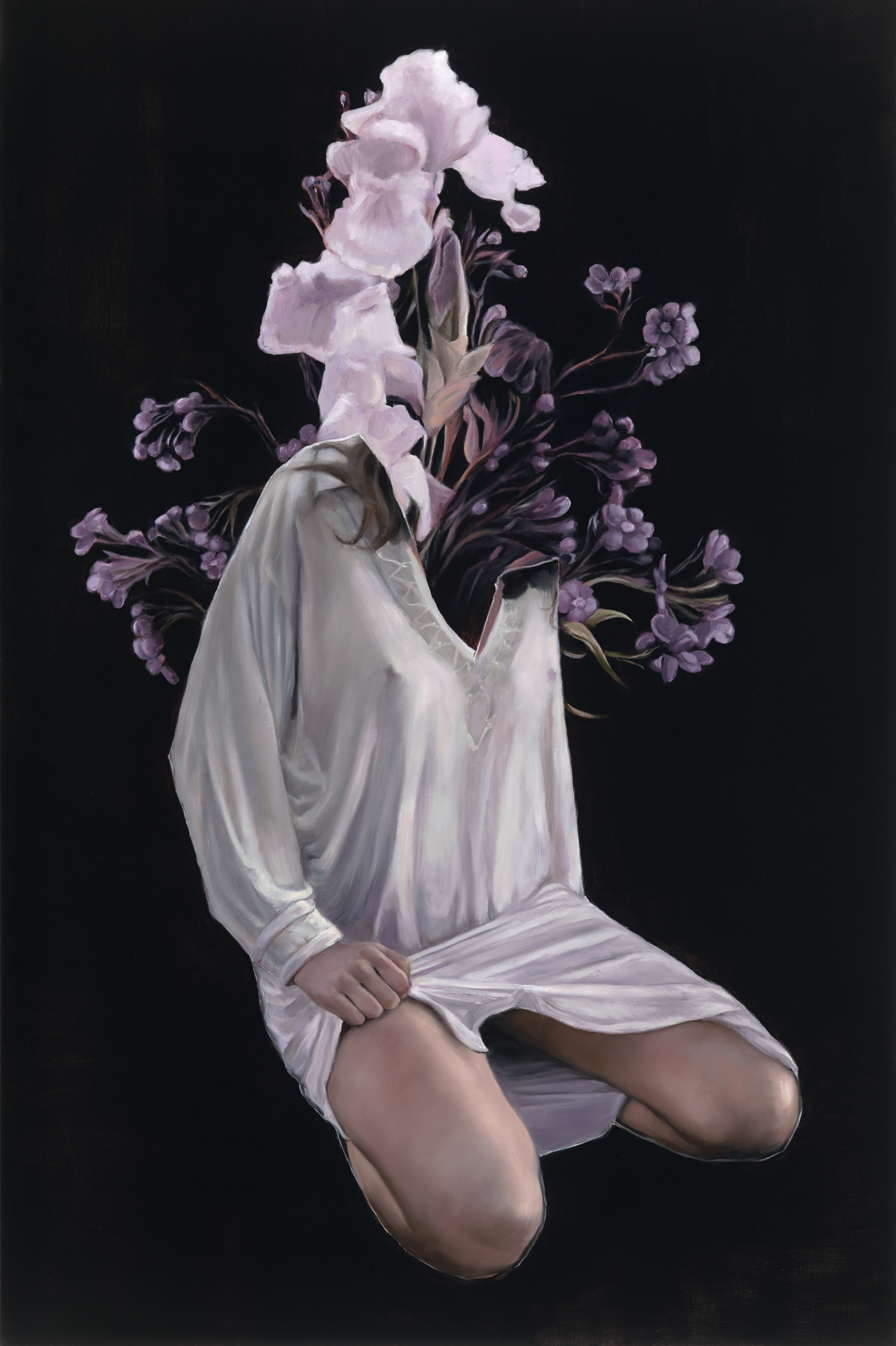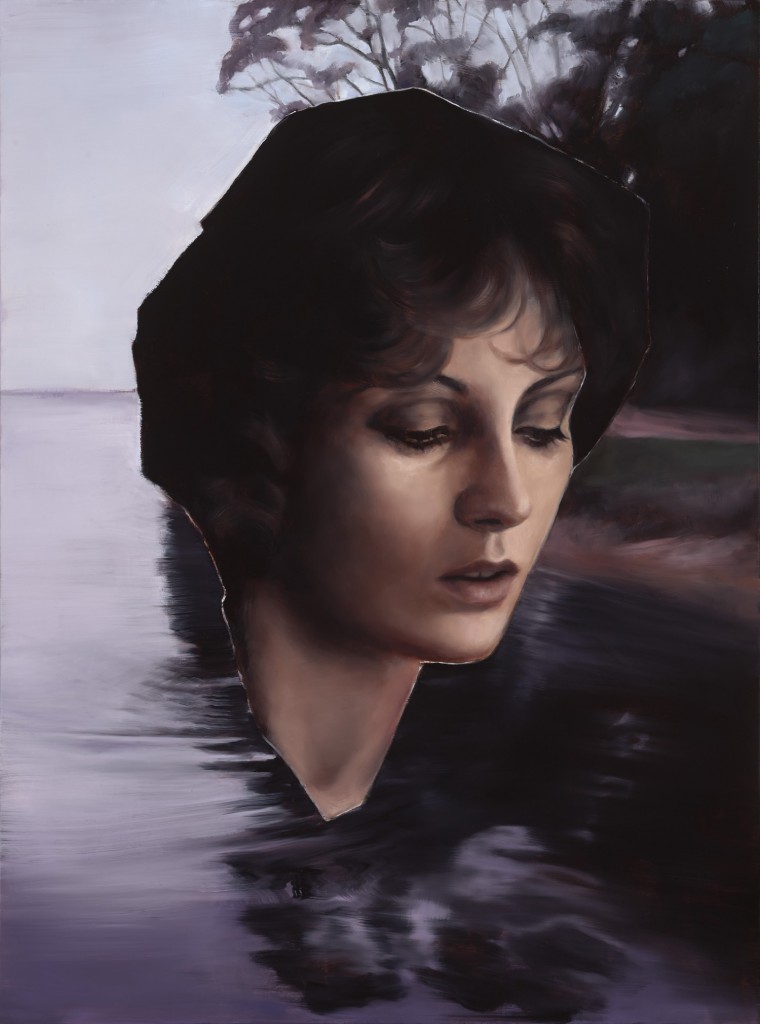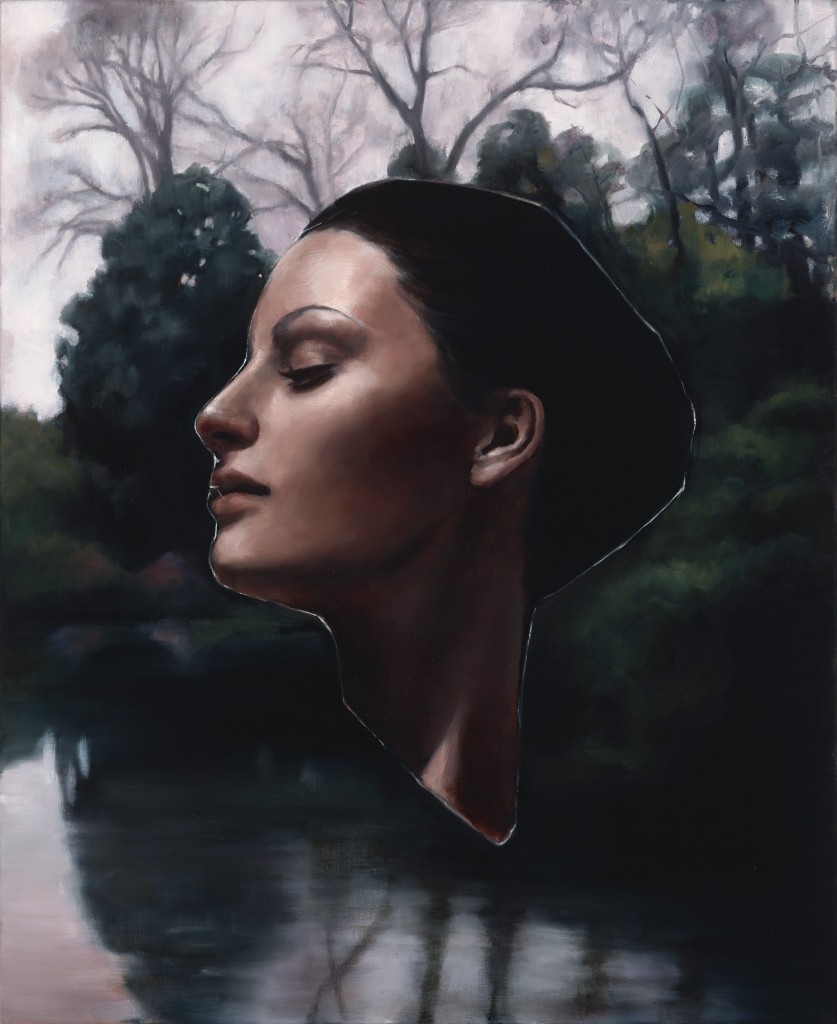Heidi Yardley looking through the Glass Psyche

Australian artist Heidi Yardley goes through the looking glass darkly in her new exhibition Glass Psyche. Through the surreal language of a haunted imagination, an alternative other world appears like the shards of memory arising from colonial history. Notions of displacement, ownership and belonging are explored through references to our relationship with the natural world. Beguiling and bewildering as the esoteric realms her art explores, Yardley enters the “in-between” and tempts us to follow her down the rabbit hole.
image above: Heidi Yardley, Glass Psyche, 2013, oil on linen, 122 x 80cm
AWW: The title of your latest exhibition Glass Psyche is intriguing. Can you tell us how you came to this name and what it stirs for you?
HY: I often use song titles or lines from poetry as painting and exhibition titles. I make lists and try to find words and ideas that seem to resonate with the work. In this case I started to mix up the words to see what would appeal to me on an intuitive level, which seemed to be in keeping with the collage process used to create the source images for the paintings. ‘Glass’ is an evocative word and can refer to a transparent barrier, reflection, mirrors, a window or portal to another place. There is also a sharpness and danger to the rough edge of shattered or broken glass. ‘Psyche’ suggests the realm of the mind as well as states of being and also refers to my interest in psychological themes.
AWW: You evoke an “other worldliness” in your paintings, somewhere between what is remembered and the residues of haunting dreams. Presence without form in “Glass Psyche”, the feminine effusion of flowers sprouting forth where a head and body should be, from the absence of the mortal being, yet implied in the eroticism of a lightly draped white night dress and the seductive opening of thighs an invitation into dark places. The subconscious and unconscious are palpably and visibly present in your work. What is the attraction for you in exploring these?
HY: I have always had an interest in the power of the subconscious. I like the way art, music, literature and poetry can evoke deep emotive responses without being something that is necessarily always understood on a surface level. The world of imagery in art is really the world of the imagination and anything is possible. To me it seems that it would be hard for the subconscious not to play a part in the creative process. I feel that this ‘other world’ is one that I always desire to tap into as an artist.

AWW: There is a sense of dominion in the space, a claiming of presence and inference of relationship in these regal female forms who are all the more intriguing and curious for their unexpected juxtapositions within your watery landscapes. How do you perceive our relationship with the natural world?
HY: I think we currently have a very difficult relationship with our natural environment because of the dominance of industry, power structures and lifestyle expectations that have caused such extreme damage. It feels as though we are watching and waiting for the beauty of nature to disappear even though we know we can’t live without it. There are still cultures and communities who live every breath in communion with the land which is a much more natural way to exist. In the Western world and particularly for those living in urban environments the beauty of nature is often packaged as a holiday destination, something you enjoy for a short time and then return to ‘the real world’. We also see land as something we can own, which I don’t believe is ever really true as each of us is only here for a short time. Interesting that you described the female forms as ‘regal’ as I had intended to make a subtle reference to Australian colonisation and the monarchy – the strange female arm (‘Inheritance’) that reaches out across an Australian landscape was meant as a metaphor for the Queen’s governance.
AWW: What is the appeal for you of darkness and “dark beauty”?
HY: My fascination with art started early and I have always been drawn to paintings from history that could be described as having a ‘dark beauty’. I was particularly influenced by the work of Edvard Munch and Egon Schiele at art school. I also studied the works of Otto Dix, Max Beckmann and many others who often made works in response to tragedy such as family deaths and the horror of the first and second world wars etc. What came out of these difficult times was really intense and meaningful art and that kind of work compelled me to want to be an artist. Having said that, I was also a fan of a number of the Symbolists whose work was less brutal and seemed to enjoy beauty for beauty’s sake. I still love Goya, Redon and a number of others from that period.

AWW: Collaging is a kind of violence, in the tearing and severing that the process entails, yet it can also be generator for new connections and a tool in the evolution of imagination. In your work, the fragmenting and shock of overlaid images, body parts severed and displaced, recombined and arranged as objects in a still life, a severed arm floating in a landscape, a head floating above a body of water, all could be read as a kind of violence, or is there something else you are doing in the activating of imagination?
HY: Collage provides an exciting ‘hands-on’ process of image making that draws heavily on intuition. The act of cutting is a kind of violence that is intriguing in itself but I’m more interested in this as a metaphor for displacement or fragmented memory. I’m not particularly interested in violence as a considered subject within my work. I also like to keep the look of the collage in the final paintings including the thin white lines of the cut paper. This refers back to a process that could now be seen as redundant (cutting and pasting) considering our ability to perfectly merge and blend imagery in the digital realm with programs such as Photoshop, and of course our ability as painters to merge images through the process of painting itself. This is a kind of subversion I have used to shake up the traditional expectations of landscape and figurative painting.
AWW: Throughout your work there has been a consistent interest in the esoteric and erotic. These are intertwined along with a dark feminine mystique. Dangerous ground for women for many centuries. How do these aspects inspire or influence your art?
HY: I am fascinated by the widespread misconception that early practices of Witchcraft and Paganism were equal to the practice of Black magic. The presentation of almost anything esoteric in popular culture seems to point to the Satanic. Although I believe that there is a real distinction between White and Black Magic (depending on which labels one would give them), I have realised what interests me more is the aesthetic that has been born out of this misconception in media such as films, fiction, photography and music. I’m also interested in how women are portrayed as being mad or evil simply for having secret knowledge. This was true of the witch trials and is also evident in many thriller and horror films particularly of the 1960’s, most notably Roman Polanski’s ‘Rosemary’s Baby’.

AWW: Does “Llorando” mean “crying? It appears to be quite a paradox because the woman who appears in your painting “Llorando” is tearless, perhaps better described to be in a state of defiance of tears rather than surrendering to such a vulnerable emotion. What place does paradox have in your work?
HY: Yes, ‘Llorando’ means crying in Spanish and you are right – this figure does not appear to be actually crying. The title references a song on the soundtrack of David Lynch’s ‘Mullholand Drive’. I liked the sound of the word and the mystery it could imply. Paradox is not something I actively seek in my work but it is interesting when it comes to choosing titles – sometimes choosing something less than obvious helps to maintain the mystery within the work.
AWW: What has been a highlight of your career so far?
HY: I would say my two-month residency in New York in 2011 was a real highlight. I had so many new experiences and was able to absorb so much contemporary and historical art as well as gain inspiration from the city itself. Another highlight would be that I have been able to commit to my practice on a full-time basis for the last five years despite all odds.
Represented by
Scott Livesey Galleries in Melbourne
Jan Murphy Gallery in Brisbane
Glass Psyche is showing at Jan Murphy Gallery, Oct 8th – Oct 26th
What an intelligent informative interview, thank you Claire and Heidi. Succinct, concise questions answered honestly. A great forum – the perfect Sunday morning read. My appreciation of this mysterious enigmatic artist has been utterly enhanced.